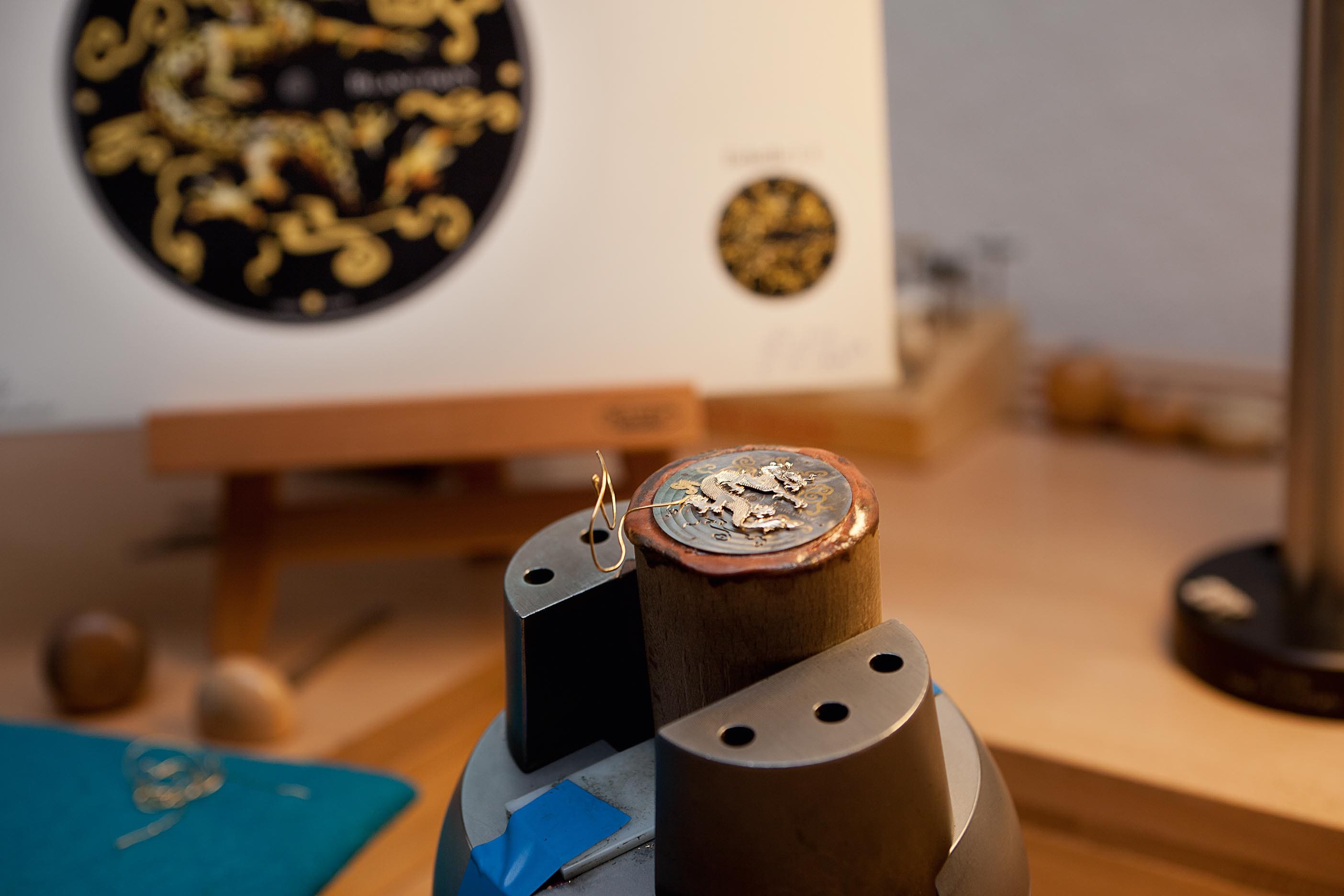Watchmaking craft techniques employed span all the recognised horological artistic disciplines. In Switzerland, watchmakers and craftsmen have been working together for centuries to create finely decorated watches. This great tradition continues at Blancpain, in its in-house decorating and engraving workshops. We produce unique decorative works, with traditional craftsmanship. Clients can have the opportunity of choosing their own designs, themes, motifs and techniques, together with our artists. This way they obtain a bespoke work of art satisfying their utmost desires.
Shakudō
Shakudō is a Japanese art dating back several centuries, prized by the Samurai for the decoration of small elements of their katanas. Today, it is practised by our artisans in the Vallée de Joux, in order to produce unique dials.
Shakudō is an alloy of copper and gold. In the traditional process used at Blancpain, it is dipped into a bath called a rokushō, which serves to modify its colour. The operation is repeated until the desired colour is obtained, one of many subtle shades ranging from black to grey or blue. When the artist achieves the perfect patina, the process is halted, and the colour is stabilised.
Very often, the shakudō is given some refining touches using complementary artistic techniques, such as engraving, damascening or sculpture.
Engraving
Hand-engraving is one of the major decorative arts in haute horlogerie. In keeping with the tradition, our master engravers produce ornamentations to decorate dials, movement bridges, oscillating weights, case backs and automatons. Their work begins with sketching by hand a drawing showing in detail the forms and their layout on the watch parts concerned. Once the design is finalised, the engravers can proceed with practising their art, sculpting the surface of their material using gravers. Thanks to variously shaped blades, it is possible to trace fine lines with these tools, using the intaglio technique, so creating textures that bring the design to life.
Damascening
The decorative art of damascening first appeared in China before spreading to the ancient town of Damascus, then to Persia and India, and finally Toledo, in Spain. Blancpain’s artists have introduced this ancient art into the world of haute horlogerie.
The design required is first chiselled out of surface to be decorated. Threads of precious metal, such as gold or silver, are then hammered into the fine grooves then smoothed down to surface level and meticulously polished. The precious metal decoration is held in place by the surface into which it has been manually inserted and hammered. The result is a work of art without par.
We produce some dials fully decorated using the damascening technique and others where the damascened work is combined with elements finely engraved by hand.
Binchōtan
Originating in Japan, binchōtan is a type of charcoal produced by traditional processes dating back more than 400 years. Of exceptional quality due to its extreme density, it is the product of slow combustion of ubamegashi oak wood (similar to holm oak) in a clay oven heated to about 1300 degrees. The sharp rise in temperature, followed by rapid cooling, reduces the tree bark to ash, leaving a smooth surface of a hardness comparable with that of steel. The artists in our Le Brassus decorating and engraving workshops adopted this technique for the production of unique dials. The binchōtan is first washed, before being cut into fine discs. These are coated with several layers of resin derived from the sap of the Chinese lacquer tree to protect the material from ageing. The discs are then polished to bring out the beauty of the grain of the binchōtan and the intensity of its colour, before being intricately decorated with a pigmented lacquer. The dials produced in this way are completed by the attachment of various decorations, such as hand-engraved and sometimes patinated gold applied chapter.
Binchōtan can also be used to create decorative inserts applied, together with grand feu enamel, to engraved gold dials.
Enamel painting
Miniature enamel painting is one of the many enamelling techniques practised by Blancpain. The watch dial is our enamellers’ canvas. Their work starts with the preparation of the surface to be painted. The artists in our Le Brassus decorating and engraving workshops delicately apply the enamel, layer by layer, to a solid gold plate, on both the top and bottom surfaces to prevent any deformation of the dial. Each layer requires baking in an oven at about 800 degrees. The enamel is then meticulously polished to give a perfect surface, without the slightest crack or defect. It is then ready to receive the coloured pigments, according to a design carefully drawn in advance. Our enamellers create the colours by mixing enamel powder, metal oxides and pine oil in an agate mortar. The paint is generally applied using brushes of microscopic marten fur. It is followed by baking in an oven. This traditional technique guarantees eternally sparkling colours.




